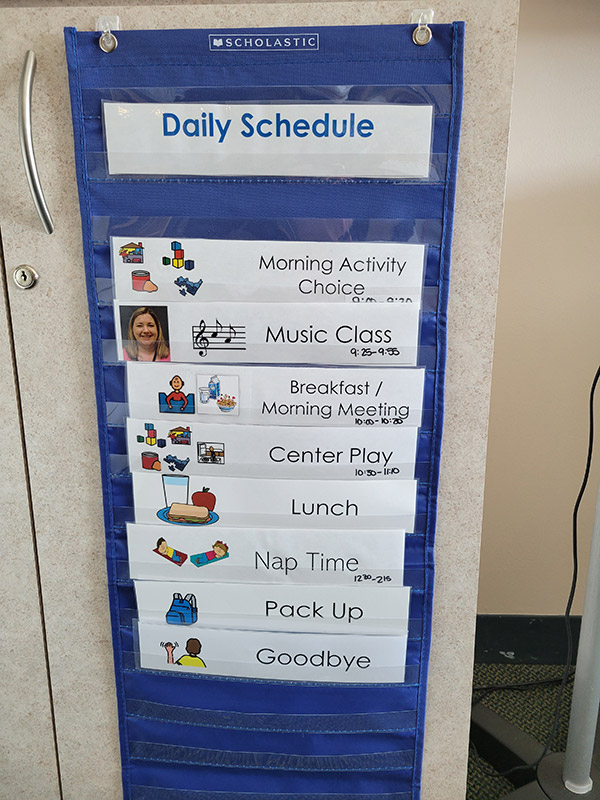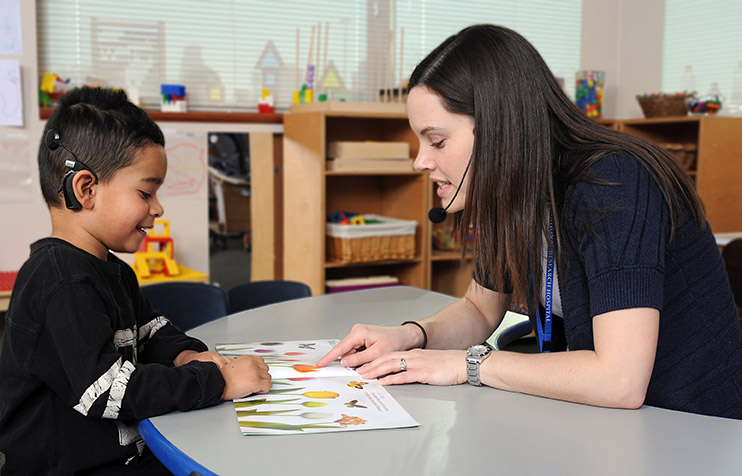*Information in this section was originally developed by a team that created a website for families focused on “raising deaf kids” (see About Us). The content may have been edited or updated.
+As a reminder, we use the term “deaf or hard of hearing" (DHH) because there are some differences in the ways that these two groups of children access sound and communication. Children who are deaf have very limited or no hearing ability and may or may not use a cochlear implant in order to hear; children who are hard of hearing have partial hearing abilities and typically benefit from hearing aids. Children who are DHH may or may not use sign language, depending on their family decisions about communication.
Here are some questions a childcare center might have about making a childcare center more welcoming and inclusive:
- How can we help make our center more inclusive to children who are deaf or hard of hearing (DHH)?
- How can children who are DHH understand movies that we play at the childcare center if they cannot hear them well?
- Where can we find more resources and information on being deaf or hard of hearing?
- What does the law say about taking care of children with disabilities?
How can we help make our center be welcoming to children who are DHH?
- Use a picture schedule (draw basic pictures, or use a digital camera and printouts) to show what the day's activities look like. This will help the child who is DHH understand her day, and possibly look forward to certain events. The schedule can be used to answer some of their questions (e.g., when is lunchtime? when can I play with blocks again?). The picture schedule can also be effective in helping the child make transitions between activities. Picture schedules help children anticipate 'what is coming next.'

- Put up pictures of all the children in the classroom. Write their names under the pictures. This may help the child learn the names of peers.
- Learn about the child's technology and become comfortable with it. Many children who are DHH use two hearing aids (one on each ear) or two cochlear implants; some use both types of technology. The child's professionals and parents can be a great resource for learning about the technology and how to use it correctly.
- Such knowledge is essential. Consistent use of hearing devices promotes language development.
- Young children may remove devices when they are tired or for other reasons. It is important to learn how to put devices back in/on and promote consistent use. For help, see
How can I help my baby adjust to wearing hearing aids? - My Baby's Hearing (babyhearing.org) and
Frequently Asked Questions About Device Use (babyhearing.org)
- If a sound system is used in the classroom, it is important to learn how to connect the child's technology to the sound system or Remote Microphone techology. The child's audiologist can be contacted to help with technology questions.
- Many children who rely on technology respond well to sound and speech around them. These children benefit from opportunities to rely on listening, like listening for their name to be called.
- If the child is learning sign language, hang up posters with sign language phrases on them like 'I love you' or 'Good job!'. You can go to www.dltk-teach.com to print out sign
language alphabet posters (http://www.dltk-teach.com/alphabuddies/asl/). These resources let people know that the center is interested in people who are deaf and sign language.
- Make changes to your childcare center to make it easier for the child to hear and see. For example:
- Use carpeting or mats to reduce the noise of moving chairs.

- Background noise, like TV or music can make it harder for children who are DHH to hear the teacher or other children. It will help to limit the amount of background noise if possible.
- When noise is present, it helps to get close and on the child's level before speaking face to face (see photo). These habits will help limit the impact of background noise.
- Hearing aids and cochlear implants amplify all sounds and a child who is DHH may let you know if some sounds are too loud.
- Use shades or curtains and indirect lighting so it's easier for the child to see what is going on.
- Give training on effective communication habits to all staff. Train all staff to know how to work with children's hearing devices. Early intervention providers (Infant-family teachers or speech therapists) often offer this type of training.
- Give training on establishing guidelines for creating an auditory and visual environment that will support development.
- Give training on being deaf or hard of hearing and sign language instruction to staff who are working with children who sign.
- Use texting or a Video Relay service to contact deaf adults. Ask deaf adults what the best way to reach them is.
- Invite a deaf adult to come to the childcare center. They can talk to the children and parents about being deaf and about sign language.
- Invite a hard of hearing adult to come to the childcare center. They can talk to the children about strategies that help them communicate.
- Children who are DHH benefit from seeing adult role models who are DHH.
How can children who are DHH understand movies that we play at the center if they cannot hear them well?
- Ask the child's audiologist for help in linking the child's technology to the sound system. This will provide better, direct access to the sound.
- Today, many movies you access from the internet will have closed captioning available. Be sure to look for the “CC" symbol and use captioning, even if the child is not yet reading.
- Show children events and videos that use deaf people and sign language.
Where can we find more resources and information on being deaf?
What does the law say about supporting children with disabilities?